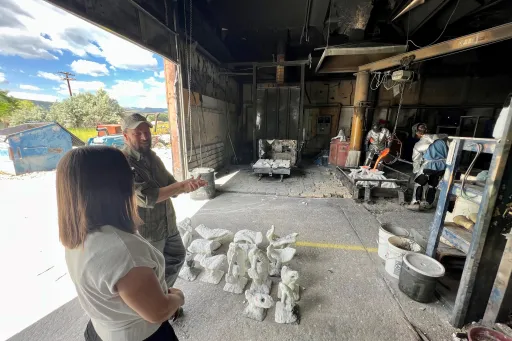Lander Business Continues Building their Legacy

Lander, Wyo. – Eagle Bronze, a foundry in Lander known for their remarkable bronze statues, was started in 1985 by Monte and Beverly Paddleford. The business, which employs more than 35 people and has been responsible for creating some of the most recognizable bronze features in the world, comes from the humblest of beginnings.
“Beverly’s father, Bud Boller, an artist and a sculptor, had built a small foundry in Dubois, Wyoming, and I had helped him there a little bit to get it started. Beverly and I always thought if we were to get into business, a foundry might be a good way to go,” Monte Paddleford explained during a recent interview at the Eagle Bronze facilities. “And, after working for some different companies in different places, the opportunity presented itself for us to build our own small foundry here in Lander. Originally, we simply planned to cast bronze sculptures for her dad and perhaps a couple of other artists, but obviously we’ve grown since then.”
The business grew gradually and, like many others in the industry, relied primarily on word-of-mouth to contract projects. In 1992, word eventually made its way to Glen Rose, Texas, where artist Robert Summers had been commissioned to create a larger-than-life-sized 19th century cattle drive to be placed in the middle of downtown Dallas. Summers contacted Paddleford, and his vision would eventually become a reality – it’s now the largest bronze monument in the world, complete with three cowboys on horseback and 70 steers.
“Logistically and technologically speaking, there were some things we did that hadn’t been done before. It would have been impossible from a budgetary and timing perspective for the artist to create 70 unique steers,” Paddleford said. “So, the artist sculpted 10 steers and we found ways to make each of them unique, whether it be swapping tails or horns or ears, which is far more complex than it sounds, and the project ended up being a huge success. That’s what really put us on the map.”
In order to complete the project, it became clear that Paddleford and the team at Eagle Bronze would need to upgrade their facilities. A U.S. Small Business Administration loan provided the necessary capital to build the larger facilities the company uses today.
“We’d worked with SBA prior to the project, but they were instrumental in helping us get into our larger building on the campus. A number of things needed to happen for that building to be built, and SBA played a vital role,” Paddleford said.
Since then, Eagle Bronze has continued to cast sculptures for artists across the country. For many years until his death, the company was the sole foundry used by Arturo Di Modica, the artist responsible for the “Bull of Wall Street,” “Shanghai Bull,” and many other prominent sculptures.
What sets Eagle Bronze apart from other foundries is their ability to work with an artist or client from “A to Z.” This means every step of the process – whether an artist brings in a sculpture or a client needs to be connected with an artist – is handled in house. Clay sculptures become plaster, which becomes a ceramic mold, which is filled in the “melting room” and sent to their team of welders after cooling to finish assembly. Colorization of the statues is completed in the “patina” room. Eagle Bronze, if necessary, will even deliver and assemble larger pieces on-site. This allows artists to be involved in each step of the process to ensure their work is perfect and up-to-standard. The foundry even has the ability to enlarge smaller sculptures to nearly any size.
“We wish we’d have kept a journal of every project we’ve done,” said Beverly Paddleford, an artist herself. “We just imagined we’d always stay small, and since we’ve grown it’s becoming more and more difficult to remember every detail that went into these projects. We feel so blessed to have been a part of this journey and to spend almost our entire life doing this. It’s a hard business, but very rewarding.”
Recently, an employee of the company, due to the type of equipment on-hand in the foundry, brought up the idea of starting a side-business focused on converting “sprinter” vans and other similar vehicles into camping rigs, mobile offices and more.
“So, now we’re kind of an incubator for that business as well. I thought it was a good idea, that market is exploding right now, and some of our employees who’ve been with us a long time were excited about it,” Paddleford explained. “I think that’s what business is all about, and I look forward to seeing what the future holds.”
###
